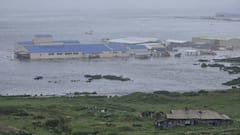Canada's Quebec Now Hopes Rain, Outside Help Can Go A Long Way In Fighting Wildfires
According to officials, by Monday, there will be around 1,200 fire fighters, including over 100 from France, that would engage in battling the raging wildfires.

New Delhi: As the Canadian firefighters are battling blazes amid the wildfires emanating toxic air over a week, the province of Quebec on Saturday said it hopes that a little rain and outside help could help the authorities win the fight against the forest fires, news agency Reuters reported. According to officials, by Monday, there will be around 1,200 fire fighters, including over 100 from France, that would engage in battling the raging wildfires.
"Some rain is forecast ... in the next few days there is a risk the situation will stay critical. But the arrival of French firefighters is really going to help," Reuters quoted forestry minister Maite Blanchette Vezina as saying.
The weather office has predicted rainfall over the weekend. “Whether or not that rain ... is enough to douse the fires, that remains to be seen,” meteorologist Gerald Cheng said.
In the wake of the raging forest fires, more than 13,000 people have been evacuated from north Quebec.
Meanwhile, after engulfing New York City and Washington DC, smoke emanating from the Canadian wildfires reached Norway.
As per Nikolaos Evangeliou, a senior scientist at Climate and Environmental Research Institute in Norway (NILU), people in Norway might be able to smell and even notice the smoke as a light haze but, unlike parts of the United States that have seen hazardous pollution, they should experience no impact on health, as reported by CNN.
“The fires traveling from such long distances arrive very diluted,” he told CNN.
“Smoke from wildfires such as those in Canada is injected at high altitudes thus staying in the atmosphere longer and able to travel over far distances,” he added.
Meanwhile, as the smoke is forecast to continue spreading across parts of the East this week, air quality alerts have been issued along a nearly 850-mile-long path from South Carolina to New Hampshire in the United States.





































